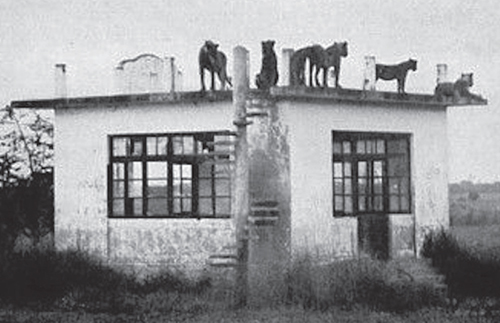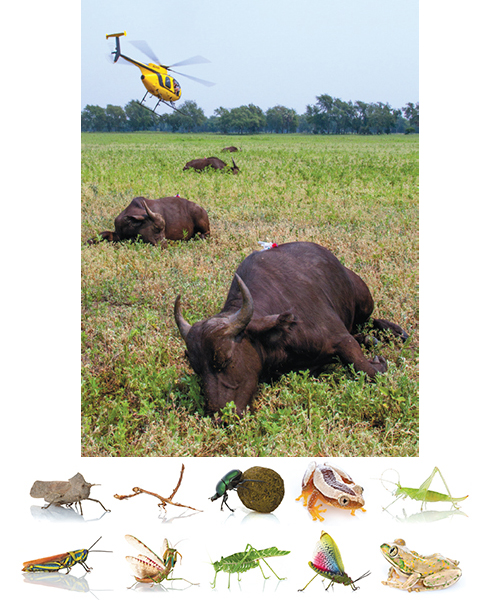War and Redemption in Gorongosa
By Edward O. Wilson
Mozambique's astonishingly diverse national park was decimated during a bloody uprising. Now it is rebounding, with the aid of some tiny helpers.
Mozambique's astonishingly diverse national park was decimated during a bloody uprising. Now it is rebounding, with the aid of some tiny helpers.

DOI: 10.1511/2014.108.214
Near the center of Chitengo Camp stands a 10-foot-tall, bullet-pocked slab of concrete, once part of the wall of a restaurant. It is a remnant of the 1973 attack by Frelimo insurgents during the war of independence against Portugal. Today it serves as a monument to two achievements—the birth of a free Mozambique and the rebirth of its premier nature reserve.

Piotr Naskrecki
The restaurants and cottages were filled that day with staff and guests, the latter mostly Portuguese nationals. Suddenly a line of guerrillas emerged from the edge of the woods and began firing into the sides of the buildings, the electric lights, the windows, taking care not to hit any of the people scurrying for shelter. Their desired effect was achieved: The next day Chitengo Camp was empty. The Portuguese rulers of Mozambique, if they needed it, were further persuaded of the seriousness of the independence movement.
The military campaign against colonial rule had been launched by Frelimo (Frente de Libertação de Moçambique) on September 25, 1964. It was met by the Portuguese rulers with superior arms, scorched earth, and the forced settlement of rural people in fortified gulags. Portuguese secret police suppressed Frelimo activity within the cities and villages by means of imprisonment, torture, and executions. By determined incursions the Frelimo forces nevertheless progressed from their Tanzanian base into the northern provinces of Niassa and Cabo Delgado, and eventually turned the tide of battle. When the regime of the dictator Marcello Caetano was overturned by a coup in Lisbon in 1974, the Portuguese finally faced the inevitable and ceded the country to a transitional Frelimo government. The People’s Republic of Mozambique was formally proclaimed on June 25, 1975.
To have a black communist state next door was anathema to Mozambique’s neighbors South Africa and Rhodesia. The principal part of their response, exceeding even an embargo, was the creation of Renamo (Resistência Nacional Moçambicana). On paper an indigenous anticommunist army, it was in reality a well-armed military force launched by the Ian Smith colonial government in Rhodesia with the sole aim of overthrowing the Frelimo regime.
When Rhodesia was liberated in 1980, changing its name to Zimbabwe, South Africa took over as the principal Renamo sponsor. The mission of Renamo from start to finish was to achieve victory on the battlefield if possible, but failing that to destroy whatever infrastructure was left in Mozambique. The total impact, to put it bluntly, was a holocaust. About a million Mozambicans died, and several million more were forced into exile, moving to refugee camps in Malawi, Tanzania, and Frelimo-occupied parts of Mozambique.

Photograph courtesy of Gorongosa National Park.
Gorongosa National Park, located well back in the interior near the center of Mozambique, was close to a headquarters of the Renamo forces, and thereby was a frequent battleground. The park is a global treasure. It has the greatest variety of habitats of any park in Mozambique, and one of the most diverse in the entire world. In the whole of the park have been found so far 398 bird species (about 250 are residents), compared with 914 in all of North America; 123 mammals, of which one indigenous species is Homo sapiens, and which is well above the 67 species living, for example, in Yellowstone National Park; 34 reptiles; and 43 amphibians.
The Renamo units at Gorongosa, who were forced to live off the land, hunted its wildlife for food. By the time the war came to a close in 1992, the wildlife of the park, especially those animals over roughly 10 kilograms (about 20 pounds), had been decimated. During the political and economic crisis that followed, while the park lay unprotected, poachers and professional hunters laid waste to the remnant, with much of the meat obtained ending up for sale in the coastal cities. Between 1972 and 2001, the number of Cape buffaloes counted in the park fell from 13,000 to just 15; the wildebeest fell from 6,400 to 1; hippos went from 3,500 to 44; and instead of 3,300 zebras there were 12. Elephant herds and lion prides were reduced by 80 to 90 percent. Of hyenas, black and white rhinos, and wild dogs, there were none.
In 2004 American businessman and philanthropist Greg Carr found in his first visit that he could walk or drive all day without seeing a living thing except birds. The same year, and in a contract with the Mozambican government, he committed funds, transmitted through the nonprofit Gregory C. Carr Foundation, to launch the restoration of Gorongosa National Park. When I visited the park in 2011–2012, Carr was constantly on the scene as he guided the complex operations of ecological restoration. These included the expansion of the summit rain forest on Mount Gorongosa by the planting of millions of tree seedlings, while rebuilding the tourist center to make the park financially self-sustaining. Carr provided hundreds of new jobs for villages in the surrounding region, and better homes outside the park as an option for those who were living inside.
The megafauna of Gorongosa National Park was growing swiftly. The rate at which this was occurring varied greatly by species: Elephants were at about 15 percent of their original numbers, whereas waterbuck had drawn to above their prewar maximum. Most wildlife species were still below half the carrying capacity. Another several decades may be needed for Gorongosa to return to its old preeminence, but given the persisting soundness of its undergirding plants and invertebrates, which survived the war intact, I believe this will surely come to pass.
My own checklist of native mammals seen while searching for ants during my five weeks’ visit over two years (a naturalist without his nose on the ground looking for ants, as is my habit, and carrying powerful field glasses, would do a lot better) includes these species: porcupine, African elephant, hippopotamus, bushpig, warthog, blue wildebeest, oribi, impala, sable antelope, nyala, bushbuck, waterbuck, lion, serval cat, African civet, large-spotted genet, mongoose, bush baby, olive baboon, and vervet monkey. And human beings.
The human assault on Gorongosa’s megafauna lasted three decades. Scientists may never take the full measure of the impact on the rest of the ecosystem—on the small mammals, reptiles, and invertebrates, including insects, not targeted by the hunters. The records of their distribution and population sizes in the park, the baseline data against which comparisons at later dates might have been made, are just too sparse to allow us to draw solid conclusions. We have, however, been able to infer some of the changes that must have occurred.

Piotr Naskrecki
In an African environment well populated by big game, their droppings (often called scat) are everywhere. The size, shape, texture, and color of each tell a great deal about the animal source. A skilled tracker uses footprints, if available, to tell the species of the animal that made them, as well as its size, sex, physical condition, and speed and direction of travel. If the ground is too hard or disturbed to read footprints, the tracker turns to scats. He can get some of the same information he does from footprints, and in addition he can learn what the animal has been eating.
Those untrained in such matters, which includes almost all the rest of us, think of animal dung, if we think about any of it at all (as when scraping it off our shoes), as just a smelly mess to be avoided. But for countless small animals a scat is a treasure, a source of life. Every milligram found is a ruby, a diamond for dung feeders. From the moment it falls warm and fresh to the ground, a host of winged beetles and flies rush to feed and lay eggs on it. The scent of skatole, along with the indoles and sulfur-containing thioles, form the essence of feces. They waft downwind and repel us, but to the scatophage insects they are like the perfume of flowers.
The reason for such a contradiction is Darwinian—the result of evolution by natural selection. For humans and most other animals, feces is food that we have extracted the most useful nutrients from and then discarded. It is loaded with bacteria that, if ingested, could infect and kill us. For dung-using insects, roundworms, and other invertebrates, on the other hand, feces still contain substances that can serve as nutrients. At the same time, for many of these animals fecal bacteria are part of their food.
Arriving closely behind the skatole-loving scatophages are predators and parasites that feed upon them. Most of these hunters are specialized forms of beetles, wasps, and flies. And when the scat dries and begins to disintegrate over a period of weeks, other kinds of predators and parasites arrive to replace the pioneers. As this miniature but vastly complicated drama unfolds, the inhabitants compete, fight, grow, reproduce, release offspring to seek other scats, then die. Simultaneously, another, microscopic world composed of bacteria and fungi churns through its own cycle, processing materials and transferring energy for the unintended benefit of larger creatures living among them.
To put the whole succinctly, the unlovely scat is an ecosystem, vital to the larger world of antelopes and lions on which we are prone to focus. It passes through a series of stages, biological and chemical, starting with fresh feces and ending in remnants of materials that sink into the soil, where it promotes the growth of plants. The history of the scat ecosystem is basically similar—on a smaller scale of space and time, of course—to the transformation of a pond into a bog, or to a pasture that turns first into a grassy meadow and then into a forest.
A parallel class of ecosystems occurs in the decay of bodies. In a healthy African savanna environment, most of the remains of large animals are quickly consumed by predators and scavengers, principally lions, leopards, wild dogs, jackals, and vultures. The sparse rotting fragments, consisting mostly of bone marrow, fascia, and cartilage, are attacked by a succession of small organisms, which are different from those in scats.
When the Gorongosa megafauna was almost destroyed, the scat and corpse decomposers were comparably diminished. It might seem likely that this segment of the fauna suffered many species extinctions, because they are a link in the food chain below the megafauna and dependent on the widespread distribution of products provided by the big animals. It is further true that scat and carrion feeders must locate them at distances proportionate to their small size, which are vastly greater than the distances facing the large animals that provide the resources. A blowfly, for example, traveling 100 meters to reach its odoriferous goal must, when corrected for body length, cover the equivalent of about 20 kilometers (roughly 12 miles)—in other words, from one end of the park halfway to the other.
You may have noticed that upon entering a meadow, woodland, or even your backyard, which at first glance seems free of insects, there will soon appear a great many of some bloodsucking fly or other, whether deerflies, mosquitoes, buffalo gnats, or ceratopogonid midges (“no-see-ums”). How is it possible for the bloodsuckers to find us so quickly? The reason is that they use the same rule of thumb as do the insect seekers of feces and carrion. Human beings emit streams of more than 100 kinds of airborne odorants, from carbon dioxide to complex hydrocarbons. These inadvertently broadcast our presence to the insects that depend on animal blood and have accordingly evolved a hyperacute sense of smell—our smell.
In the dry forests and savannas of sub-Saharan Africa, the first such specialist you may feel landing on your neck or arm is frequently a tsetse fly. When I first slapped one and examined it in the palm of my hand, I thought, “So this is the great scourge of Africa.” The 23 species of tsetse flies known are each about the size of a housefly, but easily distinguished by their long, biting proboscis, which extends straight forward from the head like the needle of a dart.
Tsetse flies are, paradoxically, the principal reason why wildlife sanctuaries such as Gorongosa exist in the first place. Early European settlers found that the grasslands and savannas of Africa are ideal country for cattle, just as they are ideal habitat for antelopes, Cape buffaloes, and other large native herbivorous mammals. The African drylands, however, are also home to tsetse flies—and to the trypanosome protozoan they transmit that causes sleeping sickness, lethal to both cattle (in which it is called bovine trypanosomiasis) and human beings. The symptoms are anemia, lethargy, and progressive and irreversible weight loss. Indigenous African mammals, including oft-bitten antelopes and Cape buffaloes, tolerate the infection, but most strains of domestic cattle cannot. As an unintended result, people today can go to the African parks and experience Earth’s Pleistocene environment in almost all its glory.
Like creatures dependent on scat and carcasses, tsetse flies and other bloodsucking insects must have been diminished to some unmeasurable degree by the near erasure of the Gorongosan megafauna. However, the remainder of the park’s invertebrates, including other kinds of insects, probably remained intact. The reason is that the vegetation and soil of the park were only slightly altered by the civil war. Smaller creatures, from spiders and ants down to nematodes, fungi, and bacteria, the “little things that run the world,” as I like to call them, maintained the ancient biochemical processes that drive the ecological cycles. The same stability favored life that continued to teem in the rivers and lakes.
When I first visited Gorongosa, in 2011, the park was ready and able to receive the returning megafauna, along with clipped grass, broken trees, scat on the ground, bloodsuckers on the wing, and all the rest of the foundation of everything so enduring and magnificent.
Click "American Scientist" to access home page
American Scientist Comments and Discussion
To discuss our articles or comment on them, please share them and tag American Scientist on social media platforms. Here are links to our profiles on Twitter, Facebook, and LinkedIn.
If we re-share your post, we will moderate comments/discussion following our comments policy.